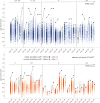Effects of multidisciplinary inpatient rehabilitation on everyday life physical activity and gait in patients with multiple sclerosis
- PMID: 38807215
- PMCID: PMC11131212
- DOI: 10.1186/s12984-024-01383-0
Effects of multidisciplinary inpatient rehabilitation on everyday life physical activity and gait in patients with multiple sclerosis
Abstract
Background: Multiple sclerosis is a progressive neurological disease that affects the central nervous system, resulting in various symptoms. Among these, impaired mobility and fatigue stand out as the most prevalent. The progressive worsening of symptoms adversely alters quality of life, social interactions and participation in activities of daily living. The main objective of this study is to bring new insights into the impact of a multidisciplinary inpatient rehabilitation on supervised walking tests, physical activity (PA) behavior and everyday gait patterns.
Methods: A total of 52 patients, diagnosed with multiple sclerosis, were evaluated before and after 3 weeks of inpatient rehabilitation. Each measurement period consisted of clinical assessments and 7 days home monitoring using foot-mounted sensors. In addition, we considered two subgroups based on the Expanded Disability Status Scale (EDSS) scores: 'mild' (EDSS < 5) and 'severe' (EDSS ≥ 5) disability levels.
Results: Significant improvements in fatigue, quality of life and perceived mobility were reported. In addition, walking capacity, as assessed by the 10-m walking test, two-minute walk test and timed-up-and-go test, improved significantly after rehabilitation. Regarding the home assessment, mildly disabled patients significantly increased their locomotion per day and complexity of daily PA pattern after rehabilitation, while severely disabled patients did not significantly change. There were distinct and significant differences in gait metrics (i.e., gait speed, stride length, cadence) between mildly and severely disabled patients, but the statistical models did not show a significant overall rehabilitation effect on these gait metrics.
Conclusion: Inpatient rehabilitation showed beneficial effects on self-reported mobility, self-rated health questionnaires, and walking capacity in both mildly and severely disabled patients. However, these improvements do not necessarily translate to home performance in severely disabled patients, or only marginally in mildly disabled patients. Motivational and behavioral factors should also be considered and incorporated into treatment strategies.
© 2024. The Author(s).
Conflict of interest statement
The authors declare that they have no competing interests.
Figures





References
-
- Baert I, Freeman J, Smedal T, Dalgas U, Romberg A, Kalron A, et al. Responsiveness and clinically meaningful improvement, according to disability level, of five walking measures after rehabilitation in multiple sclerosis: a European multicenter study. Neurorehabil Neural Repair. 2014;28:621–631. doi: 10.1177/1545968314521010. - DOI - PubMed
Publication types
MeSH terms
LinkOut - more resources
Full Text Sources
Medical

